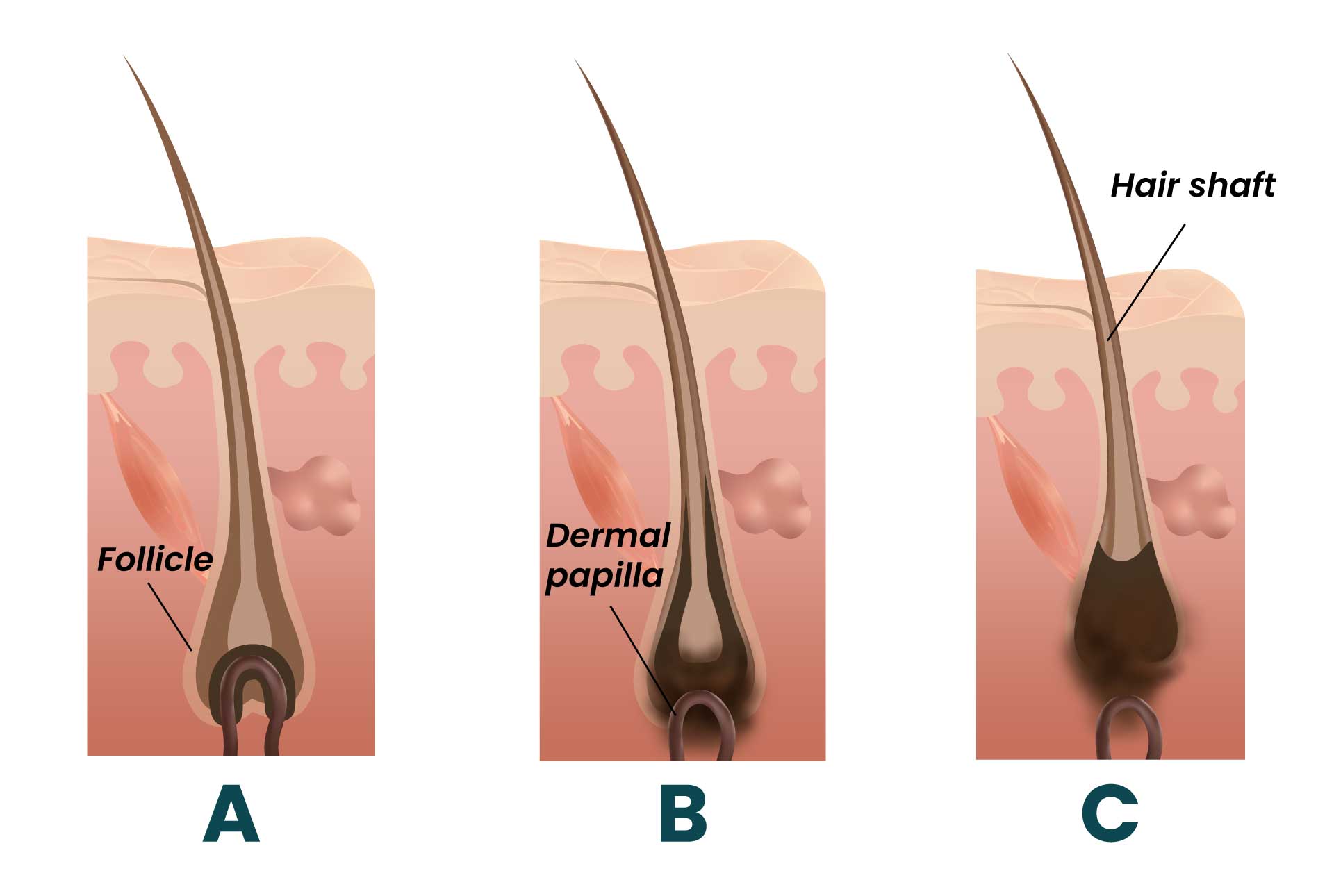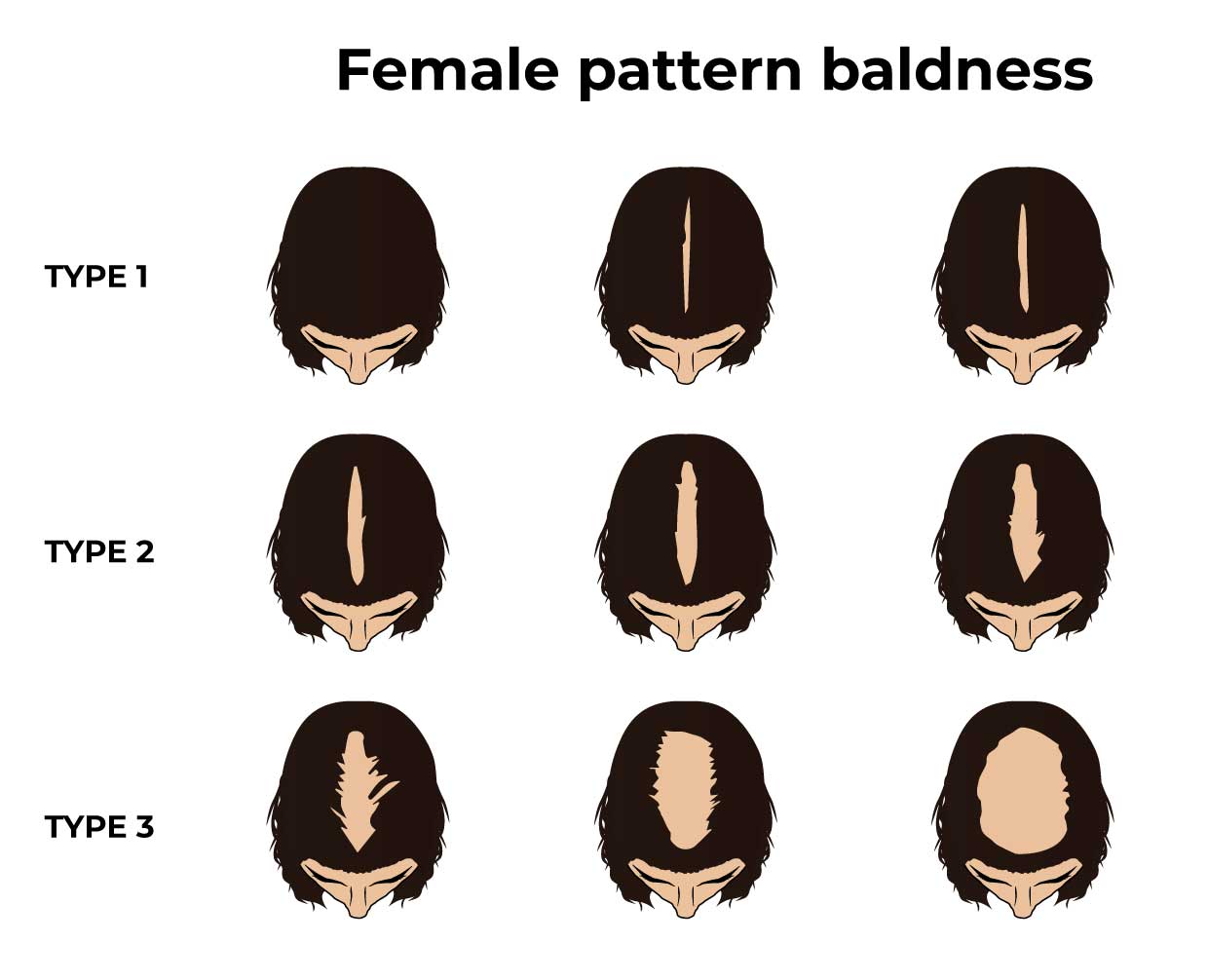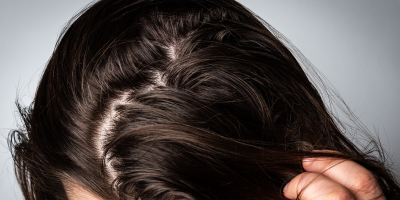Female hair loss, and how to help clients improve their confidence
Posted by Cindy E on Dec 11, 2023
Did you know that women typically lose about 100 hairs daily from the scalp? This is a normal healthy loss that usually starts at the beginning of their 30s. However, it can be double that loss for some women, which is when most women start to be concerned. Also, about 40 % of women will experience signs of thinning hair by age 50, which is more common than expected.
When should female pattern hair loss be investigated?
When the hair doesn’t grow back or starts to grow back thin, this may be the onset of female pattern hair loss. However, there are also many factors that can contribute to this that should be taken into consideration. Sometimes, elimination in a diet or a sudden shift in hormones can prevent female pattern hair loss.
If you have a client experiencing a loss of more than 150 strands, it is important to explore the root of the problem in a way that does not offend or embarrass your client. We’ll explore these methods later.
Since about one-third of women experience hair loss, and two-thirds suffer from hair thinning or bald spots, more women are seeking advice from specialists on managing their concerns. Therefore, stylists should understand what occurs with female pattern hair loss and find solutions for their clients.
Hair loss in women can often have a more significant effect than it does in men, as societal norms make it less socially acceptable for women to experience such a condition. Hence, hair holds significant emotional value for many women, making it an exceptionally delicate subject for some individuals to raise.
Life cycle of a hair

Hair loss can start any time after puberty, but women tend first to notice it between their 30s and menopause when hair loss typically increases. The risk rises with age and may also be higher for women with a history of hair loss on either side of the family.
Before starting to understand hair loss we need to understand how the hair grows and the life cycle of hair. There are three phases in the life cycle of the hair where each hair develops from a follicle which is a narrow pocket in the skin. Figuring out the phase of growth they are in will determine what type of hair loss your client is experiencing.
The initial phase is referred to as Anagen (A). This is the active growth phase and extends for a duration of two to seven years. Next is Catagen (B), the transition phase, where the hair shaft ascends towards the skin's surface, and the dermal papilla (the structure nurturing cells responsible for hair growth) initiates separation from the follicle. This phase lasts for about two weeks. The final phase is identified as Telogen (C), representing the resting phase lasting approximately three months, concluding with the shedding of the hair shaft. When the hair sheds it is at the end of this phase and then the cycle begins again.
What are the types of hair loss?
Understanding the various types of hair loss and their causes can empower clients by helping them anticipate what to expect and how to manage it effectively. It's crucial to bear in mind, as a stylist, that while you can provide valuable support, offering medical advice and diagnoses is not within your purview. It is recommended to encourage clients to consult with medical professionals for accurate guidance and assistance in addressing their hair loss concerns. There are three types of hair loss patterns: anagen effluvium, telogen effluvium, and FPHL.
Anagen effluvium is triggered by medications such as chemotherapy that harm actively growing hair follicles. Telogen effluvium is induced by a higher number of hair follicles entering the telogen phase, where hair naturally sheds. Androgenetic alopecia/female pattern alopecia/female pattern hair loss (FPHL)/baldness: The most prevalent type, characterized by thinning hair on the top and sides of the head.
About Anagen Effluvium hair loss
Anagen effluvium hair loss is caused by toxic substances, including chemotherapy, radiation therapy, and certain medications. These substances trigger sudden hair loss, which can occur anywhere on the body, specifically affecting hair in the growth stage (anagen stage). In some cases, this type of hair loss may be permanent if the hair follicles are damaged.
About Telogen Effluvium hair loss
Telogen effluvium can be induced by various factors, including intense physical stress or body shock, such as significant weight loss, surgery, anemia, illness, or childbirth, leading to temporary hair loss. Additionally, severe emotional stress, including mental health conditions or the loss of a loved one, can contribute to this condition. Other potential triggers encompass abnormal thyroid function, certain medications and supplements like blood pressure medicines, gout medicines, and high doses of Vitamin A, as well as hormonal changes associated with pregnancy, menopause, or the use of birth control pills. In cases of telogen effluvium, individuals may experience substantial hair loss, yet this condition is typically temporary, and hair tends to regrow since the hair loss is happening at the final phase of hair growth.
About Female Pattern Hair Loss/ Androgenetic alopecia
The primary form of hair loss in women is known as androgenetic alopecia or female pattern hair loss. This is the most common hair loss for women, and the condition typically initiates with a progressive thinning along the part line, subsequently leading to a broader, diffuse loss of hair emanating from the crown of the head. Compared to men, a woman's hairline rarely recedes, and women rarely become bald.
Androgenetic alopecia is influenced by the activity of hormones known as androgens, crucial for typical male sexual development and performing essential functions in both genders. These functions encompass aspects such as sex drive and the control of hair growth.
Female Pattern Hair Loss (FPHL) arises from genetic factors, aging, and hormonal changes, particularly during menopause. Endocrine issues, like androgen overproduction, can also contribute. This condition involves genetically shortened hair growth phases, leading to thinner and shorter hairs replacing thicker ones. Contrary to a common myth, genetic hair loss can be inherited from both parents. Recognizing these factors is essential for effective FPHL management.
Signs of Hair loss
- Gradual Thinning: Common as people age, it involves a receding hairline in men and a broadening part in women. Frontal fibrosing alopecia may cause a receding hairline in older women.
- Circular or Patchy Bald Spots: Hair loss in circular or patchy areas on the scalp, beard, or eyebrows may be accompanied by itching or pain before the hair falls out.
- Sudden Loosening of Hair: Physical or emotional shocks can result in temporary overall hair thinning, with handfuls of hair shedding during routine activities.
- Full-Body Hair Loss: Medical conditions or treatments like chemotherapy can lead to temporary hair loss all over the body, with hair regrowth afterward.
- Scaling Patches on the Scalp: Indicative of ringworm, this condition may include broken hair, redness, swelling, and oozing. Identifying these signs is crucial for appropriate diagnosis and treatment.
EARLY SIGNS OF HAIR THINNING IN WOMEN
Certain women might not notice the thinning of their hair, and as a stylist, you may observe it while brushing through their hair before they do. Initiating a conversation about it could be beneficial since thinning hair is gradual. The sooner you identify the symptoms, the earlier you can assist clients in pinpointing the underlying cause and taking appropriate action. Additionally, it aids in assessing potential risks associated with the use of chemical products or styling for your clients.
HERE'S WHAT TO WATCH OUT FOR
If you observe any of the following symptoms, it's time to bring attention to your client's thinning hair: The client discovering more hair on their pillow or finding strands clustered in various places without brushing, noticing an increased daily hair fall when brushing their hair, recognizing noticeable patches of thinner or missing hair ( including a widening part on the top of the head), seeing the scalp through the hair or experiencing smaller ponytails, observing hair breakage. Many women also note that broadening their hair part was among the initial signs of hair thinning. If your client's part is widening, and they perceive a decrease in coverage compared to before, it may signal the need for proactive measures.
Patterns of female hair loss

Stylists can use the Ludwig Classification to identify signs of female pattern hair loss in their clients and recommend when to seek professional medical advice. Type I signifies minimal thinning that may be concealed with hairstyling techniques. In Type II, clients may observe reduced volume and a noticeable widening of the mid-line part. Type III involves diffuse thinning, resulting in a see-through appearance on the top of the scalp. If stylists notice these patterns in their clients, it may indicate the need for the client to seek guidance from a medical professional for further evaluation and advice.
Prevention
Stylists can advise their clients on prevention strategies but still recommend they seek a medical professional for the best treatment.
Preventing hair loss in women may not be feasible in cases related to disease, aging, heredity hair loss, or physical stressors like injuries. However, avoiding caustic chemicals and tight hairstyles can help prevent hair loss caused by these factors. Additionally, maintaining a healthy diet rich in essential nutrients such as vitamins, minerals, and protein may contribute to preventing some types of hair loss.
How toppers and Wigs can help
Understanding the impact of female hormonal hair loss is crucial, as it can have significant implications for mental and emotional well-being. Having your client identify the specific cause of hair loss is key to devising an effective style that does not compromise their natural hair growth. Whether it's related to hormones like DHT, estrogen, thyroid hormones, or stress hormones, women who experience hair loss will seek your guidance on reducing the loss's visibility. That’s why incorporating toppers or wigs can be a valuable part of the hair loss journey. These options provide a versatile and stylish way to manage hair volume and appearance changes. However, it's important to recognize that while these solutions offer cosmetic benefits, seeking guidance from a medical professional is crucial for a comprehensive and personalized approach to treatment. A healthcare provider can provide insights into the underlying causes of hair loss and recommend appropriate medical interventions to address the specific hormonal factors contributing to the condition and whether or not hair toppers and wigs would be a better solution. For more information on Superhairpieces Human Hair Wigs and Hair Toppers, visit www.superhairpieces.com.
 Likes
Likes


 USD
USD












